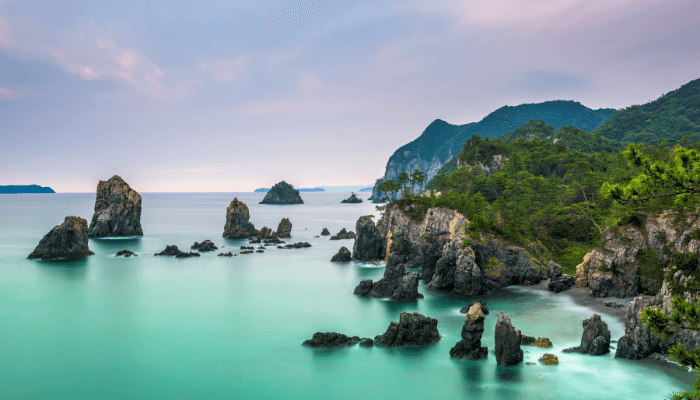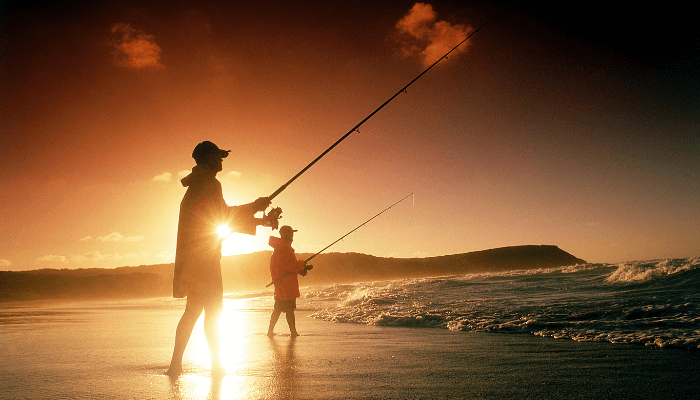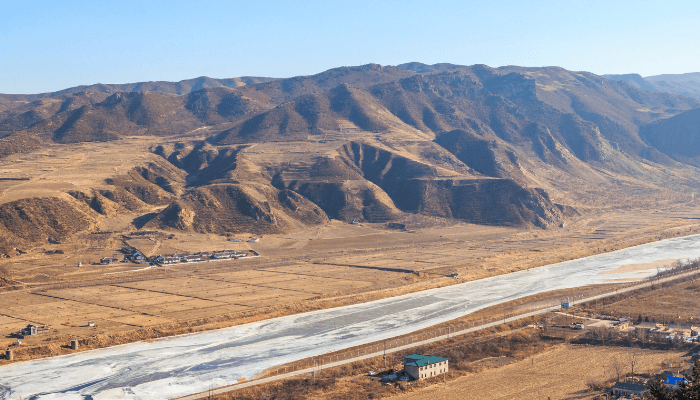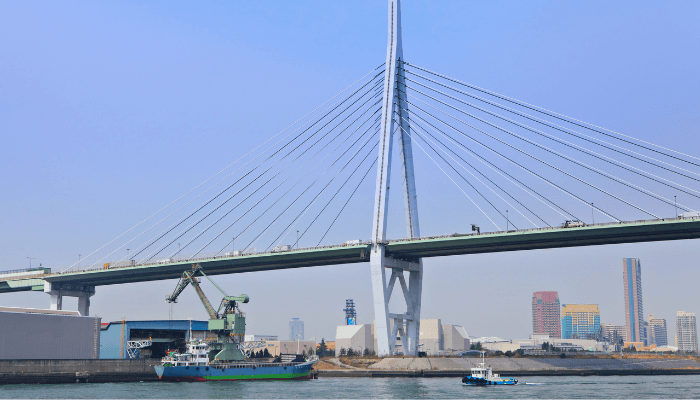11 Important Facts About The Sea Of Japan
The Sea of Japan is a semi-enclosed Sea lying on the northwestern part of the Pacific Ocean. Also called the East Sea, it is surrounded by mainland Russia and Sakhalin from the north, the Korean peninsula borders it from the west while the Japanese archipelago consists of Honshu, Kyushu and Hokkaido define its eastern and southern borders.
A marginal sea of the Pacific Ocean, the Sea of Japan is carrot-shaped when viewed from space. Its surface area amounts to 1,050,000 square kilometres with an average water depth of 1752 metres and a maximum depth of 4568 metres. Dohoku seamount, an underwater volcano, is its deepest point.
The sea is broad from the south and tapers northward. It forms a 7600-kilometre-long coastline dotted with important industrial cities and towns.
The sea of Japan is a crucial water body for not one but many reasons which will be explored in this article.
1. Formed 15 million years ago due to volcanic activities and plate tectonic movement
About 20 million years ago, Earth was being remodelled by tectonic movements and drifting landmasses, giving birth to present-day continents. Rapid Volcanic eruptions and division of the Eurasian supercontinent led to the separation of the Oki Islands and the Japanese archipelago.

As the supercontinent broke into small landmasses, some of them sank and others collided or expanded considerably. The Korean peninsula and Japanese islands stretched, giving rise to a depression that ultimately turned into the Japanese Sea. A lake was formed, inhabited by alligators, sharks and other life forms, as confirmed by paleontological evidence. A stratum dating back 16 million years ago sheds light on the formation of the Sea of Japan.
A study of fossilised remains from the region showed that the Japan Sea expanded steadily during the early Miocene period as parts of the Japanese archipelago drifted even further, transforming the lake into an inland sea.
2. Connected to neighbouring inland seas through five straits
Five narrow waterways or straits connect the Sea of Japan with nearby seas. Lying between the Asian mainland and Sakhalin, the Strait of Tartary connects it to the Okhotsk Sea and so does the La Perouse Strait situated amidst Hokkaido and Sakhalin. Situated in the centre of Hokkaido and Honshu is Tsugaru Strait which links the Sea of Japan with the Pacific Ocean. The Kanmon Straits passing through Honshu and Kyushu lead to the Seto Inland Sea while the Korea Strait waters flow into the East China Sea.
Most of these straits are recent geological formations, the oldest being the Tsugaru and Tsushima Straits, formed more than 5 million years ago. The topographic and climatic changes during the Neogene era prompted elephant migrations from the Asian mainland to the Japanese archipelago around 2.5 million years ago. La Perouse is the youngest Strait of the group, born in the Holocene epoch around 50,000 to 11,000 years ago, closing the land bridge once used by mammoths for crossing over to Hokkaido.
A common characteristic of these straits is their shallow water depth. They are less than 100 metres deep, hindering water exchange and separating the waters and marine life of the Sea of Japan from other inland water bodies.
3. Naming dispute around the ‘Sea of Japan’
Internationally known as the Sea of Japan, its naming has been a source of contention among the countries sharing borders with the strategic inland sea. It is called by different native names in Korea, Japan and Russia.
The rift dates back to mediaeval times when European colonisation efforts reached a peak. Today, South Korea calls it the East Sea or Donghae while North Koreans refer to it as the Korean East Sea. Chinese and Russians call it the Whale Sea or Japanese Sea.
Both Koreas believe that the Europeans named the water body the Sea of Japan in the 19th century, thinking that Korea was a part of Japan, as the latter had colonised it. However Korean thinkers named it the East Sea in the 20th century, as a mark of defiance against the forced Japanese invasion. After gaining independence, Korea dreamt of becoming a dominant power in the East Asian region.
4. Fishing is the main economic activity in the Sea of Japan
Due to increased amounts of dissolved oxygen in its waters, biological productivity is high, making fishing a profitable enterprise. Also, the coastal regions are rich in biomass.
The sea of Japan has over 900 species of aquatic plants and over 3500 animal species, including 950 types of crustaceans, a thousand types of fish and 25 kinds of mammals.
Ocean fish like mackerel, tuna, herring, salmon, sardines, trouts, sea breams and squids are found in abundance. Deep-sea fish like cod, bluefish, shrimp, crab, lobsters and muscles also comprise a significant proportion of the catch. Many types of seals, whales and walruses can be easily spotted in the waters.

Commercial fishing grounds are centred around continental shelves. Squid are caught in the central waters while groups of salmon usually inhabit the north and southwestern part of the sea. Deep-sea trawlers catch crustaceans in the east.
Overfishing since the Second World War has led to the collapse of some fisheries and placed pressure on the fragile marine ecosystem. Political conflicts over the division of the catch among Japan, Korea and Russia have complicated matters further.
The Sea of Japan also supports seaweed industries. Seaweed is a part of many Japanese and Korean dishes, especially sushi. It is also utilised in cosmetics production, manufacturing plant fertilisers and artificial adhesives and chemicals.
It is rich in mineral sands like magnetite and contains deposits of natural gas and petroleum, close to the northern Japanese coast and the Sakhalin region.
5. Contains three major basins and continental shelves
Having continental origins, the Sea of Japan has three basins namely the Japan Basin in the north, the Tsushima basin in the southwestern part and the Yamato Basin in the southeastern region. Japan Basin forms its deepest part while the shallowest depths are attributed to the Tsushima basin.
The northern part of the sea has three continental shelves going downwards like a stairway. The seabed is mostly even but contains some plateau areas and submarine volcanoes. It also has a ridge rising to 3450 metres from the deepest point.
Several ridges like Sado, Hakusan, Wakakusa etc are part of the Japanese coastal region. The biggest Yamato Ridge is made of granite, andesite and basalt. Covered with volcanic rocks, it is uneven and considered of oceanic origin. The sea floor up to 300 m is made of mud, gravel, sand and rocks while deeper regions consist of hemipelagic sediments, deposited millions of years ago.
6. Home to several islands and coastal communities
A calm sea, it has no tides due to its insularity from the open ocean. It has many island groups, the smallest situated near its eastern coastline while larger ones are found towards the south.
Ulleungdo Island covers 120 kilometres and is a famous tourist destination in the Sea of Japan, connected to mainland South Korea via ferries and boats. Made of volcanic rocks, it is renowned for being a cruise destination and harvesting squid.
Another significant island is Moneron, part of mainland Russia. It spans 30 kilometres and is perfect for scuba diving and water-surfing. Tourism infrastructure was built in 2006. The earliest Marine park in Russia was opened on this island.
Rishiri island lies near the coast of Hokkaido, Japan. Numerous streams, lagoons and ponds lie at the foot of Mount Rishiri. It has a bird sanctuary housing black-tailed seagulls and Asian Robins.
7. Peter the Great Gulf is the largest Gulf of the Japanese Sea
Spanning 185 kilometres from the border of Russia and North Korea, Peter the Great Gulf lies on the southern coastline of Primorsky Krai. A prominent Russian city, Vladivostok and the third biggest town of Krai called Nakhodka are situated along its coast. The gulf has a 1500 kilometre coastline dotted with beaches, small islands and minor bays. It is a popular holiday destination for Russians.
The Sea has numerous Bays such as the East Korea Bay, also known as the Broughton Bay, lying between Hamgyong and Kangwon. The region around it was once popular for whale hunting. The Japanese Bay of Ishikari is lined with crucial ports. Located on the northern shores of Honshu is one of the largest bays in Japan, the Toyama Bay. It serves as a nesting ground for the firefly squid and shares borders with the Noto Hantō Quasi-National Sanctuary.
8. Experiences a monsoon type climate
A combination of warm waters and monsoon type weather leads to intense evaporation especially from November to March. After this period, powerful north-western winds bring dry and chilly air to the coastal areas.
Places located further south experience snowfall, especially the hilly terrain on the western Japanese coastline. Storms, tsunamis and typhoons are formed during the winter monsoons, with waves reaching over 30 feet. Most of these hit Japan, causing loss of life and property. Typhoon Vera is recorded as the deadliest tropical cyclone in the history of modern Japan. It struck the western coast on 20th September 1959 killing over 5000 people.
January and February are the coldest in the Japanese Sea, with temperatures dropping to minus 20 degrees celsius. Part of the Siberian peninsula and Tartary Strait freezes completely for five to six months. The region becomes navigable with the arrival of Spring in April. Summer months are categorised by weakening and reversal of the wind system. Hot and humid winds blow from the Northern Pacific region to mainland Asia.
Two prominent counterclockwise sea currents define its hydrology. Circulating in the southern part of the sea, Tsushima is a cold current which brings warm and saline water from the Bering Sea to the north. Kuroshio current flows from the eastern Japanese coast, carrying warm waters from Taiwan.
9. Tumen is the largest river draining into the Sea of Japan
Many Asian rivers flow into the Sea of Japan, the largest being the Tumen or Dooman river. It is 521 kilometres long and serves as a border between North Korea, Russia and China. It originates from Mount Paektu and has a 13,000 square miles drainage basin.
Partizanskaya is a major Russian River that flows from Primorsky Krai, originating from the Sikhote-Alin. It is 142 kilometres long with a 4140 km2 drainage basin. Its tributaries like Tigrovaya and Melniki also flow into the East Sea. Many Japanese rivers such as the Shinano, the longest river in Honshu, Japan also flow into the inland sea.

The contribution of these rivers to the total water exchange is around one percent. 97% of water flows into the sea via the Strait of Korea and drains out through La Perouse and Tsugaru water channels.
10. Acted as a natural barrier against invasions
The Sea of Japan protected the Japanese archipelago from foreign attacks, especially from Mongol invasions. The Sea was explored and studied by European sailors and navigators in the 18th century. However, Russian expeditions had begun much earlier, in the 1770s. Soviet Russia mapped the region and studied its geographic and topographic character.
The British Challenger entered the Sea in 1853, carrying marine biologists like V. K. Brazhnikov and P. Schmidt who researched its flora and fauna. Japanese attempts to study the Sea began only in the 1920s.
As the Sea was explored, whale hunting began on an extensive scale. British, Canadian and American ships dominated the sea for over 50 years. Whale oil was highly-priced, extracted from right whales, humpback and blue whales.
11. More than 10 major seaports are situated along its coast
The Sea of Japan has emerged as a busy shipping gateway due to the growth of Asian economies and the construction of numerous ports and harbours along its coast. Vital Japanese seaports such as the Tokyo port lie on the pacific coastline.
Pusan and Pohang are crucial South Korean ports situated on the country’s southeastern shores. Ulsan is another major port which can accommodate 95 ships on its numerous berths and terminals. It handles petroleum, crude oil, containers and raw material. Ulsan is home to the world’s biggest shipyard owned by Hyundai Heavy Industries.

Nakhodka is an international seaport, positioned on the eastern coast of Russia, facing the Sea of Japan. It handles general cargo, breakbulk, metal goods, wood, grains, ores, fertilisers, cement, coal and construction material. It has an oil harbour, passenger and container terminal along with five fishing wharves. More than 10 million tonnes of cargo and 1500 ships pass through the port each year.
Disclaimer :
The information contained in this website is for general information purposes only. While we endeavour to keep the information up to date and correct, we make no representations or warranties of any kind, express or implied, about the completeness, accuracy, reliability, suitability or availability with respect to the website or the information, products, services, or related graphics contained on the website for any purpose. Any reliance you place on such information is therefore strictly at your own risk.
In no event will we be liable for any loss or damage including without limitation, indirect or consequential loss or damage, or any loss or damage whatsoever arising from loss of data or profits arising out of, or in connection with, the use of this website.
Do you have info to share with us ? Suggest a correction
Disclaimer :
The information contained in this website is for general information purposes only. While we endeavour to keep the information up to date and correct, we make no representations or warranties of any kind, express or implied, about the completeness, accuracy, reliability, suitability or availability with respect to the website or the information, products, services, or related graphics contained on the website for any purpose. Any reliance you place on such information is therefore strictly at your own risk.
In no event will we be liable for any loss or damage including without limitation, indirect or consequential loss or damage, or any loss or damage whatsoever arising from loss of data or profits arising out of, or in connection with, the use of this website.
Latest Maritime Knowledge Articles You Would Like:
Subscribe To Our Newsletters
By subscribing, you agree to our Privacy Policy and may receive occasional deal communications; you can unsubscribe anytime.















